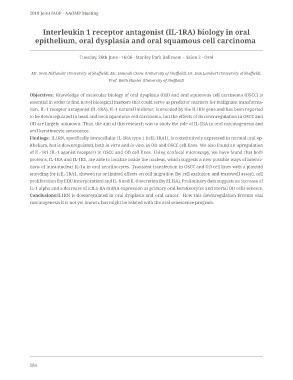Page 210 - AAOMP Onsite Book
P. 210
2018 Joint IAOP - AAOMP Meeting
Interleukin 1 receptor antagonist (IL-1RA) biology in oral
epithelium, oral dysplasia and oral squamous cell carcinoma
Tuesday, 26th June - 16:06 - Stanley Park Ballroom – Salon 2 - Oral
Mr. Sven Niklander (University of Sheffield), Ms. Hannah Crane (University of Sheffield), Dr. Dan Lambert (University of Sheffield),
Prof. Keith Hunter (University of Sheffield)
Objectives: Knowledge of molecular biology of oral dysplasia (OD) and oral squamous cell carcinoma (OSCC) is
essential in order to find novel biological markers that could serve as predictor markers for malignant transforma-
tion. IL-1 receptor antagonist (IL-1RA), IL-1 natural inhibitor, is encoded by the IL1RN gene and has been reported
to be downregulated in head and neck squamous cell carcinoma, but the effects of its downregulation in OSCC and
OD are largely unknown. Thus, the aim of this research was to study the role of IL-1RA in oral carcinogenesis and
oral keratinocyte senescence.
Findings: IL1RN, specifically intracellular IL-1RA type 1 (icIL-1RA1), is constitutively expressed in normal oral ep-
ithelium, but is downregulated, both in vitro and in vivo, in OD and OSCC cell lines. We also found an upregulation
of IL-1R1 (IL-1 agonist receptor) in OSCC and OD cell lines. Using confocal microscopy, we have found that both
proteins, IL-1RA and IL-1R1, are able to localize inside the nucleus, which suggests a new possible ways of interac-
tions of intra-nuclear IL-1α in oral keratinocytes. Transient transfection in OSCC and OD cell lines with a plasmid
encoding for icIL-1RA1, showed no or limited effects on cell migration (by cell exclusion and transwell assay), cell
proliferation (by EDU incorporation) and IL-6 and IL-8 secretion (by ELISA). Preliminary data suggests an increase of
IL-1 alpha and a decrease of icIL1-RA mRNA expression as primary oral keratinocytes and mortal OD cells senesce.
Conclusions:IL1RN is downregulated in oral dysplasia and oral cancer. How this downregulation favours oral
carcinogenesis it is not yet known, but might be related with the oral senescence program.
184

